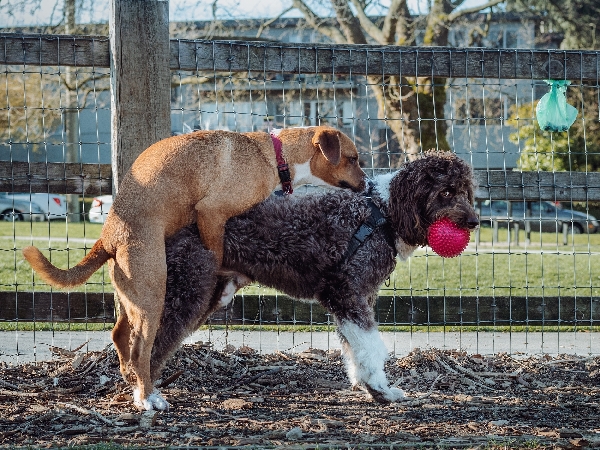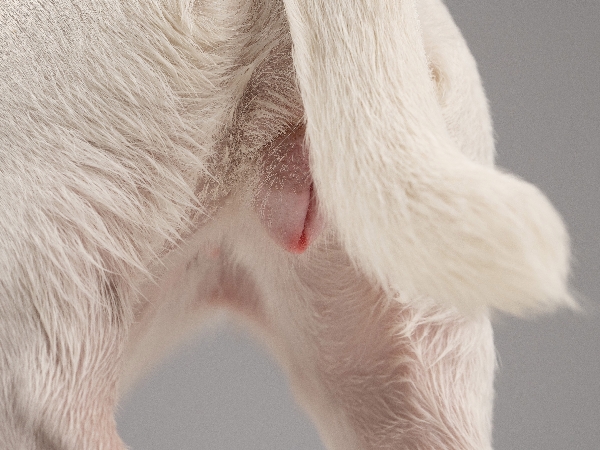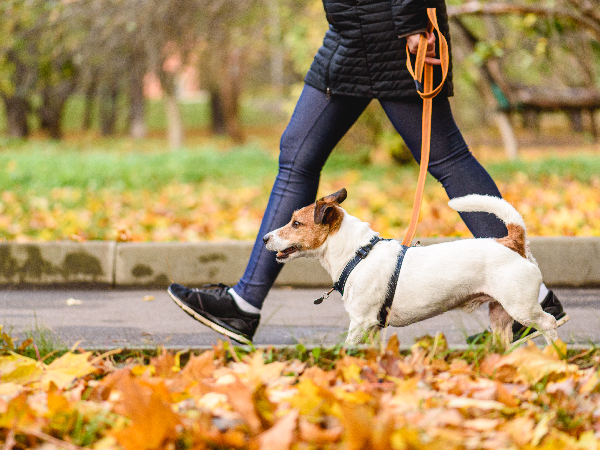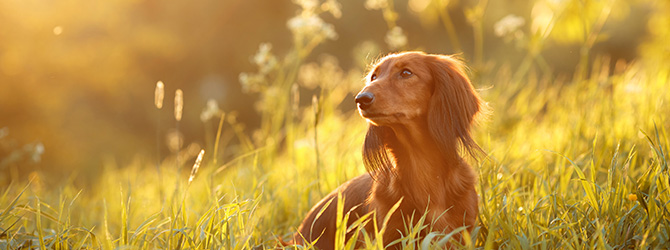How long is a dog in season? In-depth guide to your dog's first season
Your dog's first season can be a messy and difficult time for you and her, but if you decide not to neuter before their first season or you plan to breed from her in the future, it's a stage you’ll have to go through.
Let's take a closer look at your dog's heat cycle and understand your dog's first season and how to make life easier for her during this time.
Brief summary
- A dog's season is the time during the reproductive cycle when the dog is fertile and can get pregnant.
- It usually lasts around two to four weeks, and the dog may show behavioural and physical changes due to hormone fluctuations.
- Common behavioural changes during this time include irritability, anxiety, roaming to find males, friendliness with other dogs, and aggressive or defensive behaviour.
- Physical changes may include a large, red, swollen vulva, bleeding, grooming/licking the vulva, and increased urination.

What is a dog's season?
A dog's season, also known as being in heat or in oestrus, is the time during your dog's reproductive cycle when she's fertile and able to get pregnant. When in season, your dog may experience physical and behavioural changes because of the hormone changes and stress she’s feeling.
Behavioural changes can include:
- Becoming more irritable, anxious or nervous
- Roaming to find males
- Becoming very friendly with other dogs
- Aggressive/defensive behaviour
- Resource guarding
- Mounting or humping
- Standing still or moving tail to one side when touched

Your dog may experience some or none of these behaviours, which should all disappear when she comes out of season.
Physical changes include:
- Large, red, swollen vulva
- Bleeding from the vulva, or a red/brown discharge
- Grooming/licking at the vulva
- Urinating more frequently
This bleeding will continue for around 7 - 10 days, half the entire season. While most dogs will bleed, larger breeds will bleed more, and some dogs may hardly bleed. You may not notice any bleeding, depending on how clean your dog is.
During your dog’s season, they produce pheromones and hormones that are detectable by male dogs from miles away. These pheromones are particularly enticing to intact (unneutered) males who will do their best to meet your dog.
When is your dog's first season?
Different breeds and sizes of dogs will have their first season at different times. Most smaller breeds will generally have their first season at around five to six months, although this will be different for each dog. Larger breeds may not go into heat until a year or older and can be as late as 2.5 years.
On average, your dog's first season will happen at between six and fifteen months.
Your dog's first season means they have become sexually mature and are ready and able to have puppies.
How long is a dog in season?
A dog's heat cycle usually lasts for about two to four weeks. Your dog can get pregnant during this time, but she'll be especially likely to get pregnant around nine to ten days into the cycle. That's when it's really important to keep her away from male dogs that haven't been neutered, unless you want her to attract lots of attention at the park.
At the beginning of the heat cycle, your dog might not be interested in male dogs. However, this can change quickly as she becomes more fertile. Remember that every dog is different, so paying attention to your dog's behaviour during this time is essential.
Signs a dog is coming into season
Your dog will show certain signs of coming into season. It should be noted that not all dogs will show all symptoms, but some of the most common signs are:
Swollen genitals
Your dog's vulva, or the visible part of their genitals, is just below the dog's bum. It'll become large, red and swollen during their season, which can alarm new dog owners but is an entirely normal part of their heat cycle.
This swelling usually happens in the days before they begin to bleed. It may be uncomfortable for your dog, but it will return to its normal size and colour when your dog's season ends.

Vaginal discharge
Your dog may experience vaginal discharge during their season. This could be blood or a yellowish-pink discharge. Some dogs will bleed more than others, and others will be cleaner. You may see spots of blood on the floor or furniture.
Increase in self-grooming
During a dog's season, your dog will typically groom themselves more often. This is to try and keep themselves clean and comfortable. As a result, you will generally see them licking themselves a lot. Putting your dog in puppy pants may be a good option if they are bleeding heavily.
Lethargy
Your dog may be more tired during their heat cycle and seem depressed. This is normal and nothing to worry about. You can make them comfortable by giving them a cosy space away from high-traffic areas in your home and letting them rest.
Aggressive behaviour
Some dogs may become more aggressive and irritable during their season. As their season progresses, they may become more receptive to male dogs but aggressive to other bitches.
Increased urination
Dogs in heat can use their urine to alert male dogs in the area they're ready to mate. Increased urination could be a sign your dog is coming into season.
Flirtatious behaviour
If your dog is quick to roll over, back into male dogs or seek them out, it may be a sure sign your dog is coming into season. Keeping your dog on a lead and walking them away from areas with lots of dogs will be necessary during this stage.
Common behaviours of a female dog in heat
When your dog goes through her heat cycle, she might behave slightly differently than usual. Some of these behaviours will need monitoring, so knowing what to expect is important. Here are some common behaviours you might see during your dog's heat cycle:
- Trying to mount other dogs, pets, furniture, toys, or even people
- Not listening when you call her because she's focused on finding a mate
- Making a nest with toys in her crate or bed
- Acting defensively or aggressively when other dogs try to sniff her
- Marking her territory inside the house
These behaviours can change as your dog's heat cycle goes on. For example, she might be aggressive towards other dogs at the beginning and end of her cycle, but more friendly when she's most fertile.
Don't worry – these behaviours are normal, and your dog should go back to her usual self once her heat cycle is over.
Dog heat cycle: what dog in season stages are there?
The dog heat cycle is known as the estrus cycle, where your dog is most receptive to mating. This cycle can last anywhere between two and four weeks, and most dogs will have a heat cycle on average every six to seven months.
There are four stages to your dog's heat cycle
Proestrus stage
This is the first and beginning stage of your dog's heat cycle. It can be seen in the swelling of your dog's vulva and is accompanied by the start of vaginal discharge or bleeding. During this stage, your dog may become more aggressive toward other dogs, especially males that try to sniff or mount her behind.
This stage typically lasts about seven to ten days but can be as short as three and as long as seventeen. You may see your dog tucking her tail more to hide her genitals. This is natural and shouldn’t be considered a sign of distress.
Oestrus stage
This is where your dog is at her most fertile and can get pregnant. During this stage, your dog's ovaries begin to release eggs, and you may see her raising her behind to male dogs, backing up on them and being more aggressive towards female dogs. Bleeding may reduce into a pinky discharge or stop completely during this period, but they are still ready to mate and fertile.
The estrus stage of the heat cycle typically lasts for five to ten days but will differ from dog to dog.
Diestrus stage
This is where the heat cycle begins to come to an end. Her genitals will start to return to their normal size, her behaviour will begin to return to normal, and she will show less interest in male dogs.
If your dog has been impregnated during this heat cycle, this stage will last until her puppies are born, generally around 60 days later.
Anoestrus stage
This is the stage of the heat cycle where your dog isn't in heat and lasts between three and six months on average. It is also known as the resting stage and is the best time to get your dog spayed if you don't wish to have puppies or any more seasons. Waiting for anoestrus allows the hormones associated with her season to become inactive. If you spay too soon, the active hormones can produce side effects.
How often do dogs come into season?
Dogs typically have two heat cycles a year or go into season every six to seven months. However, this can vary between breeds and dog sizes. For example, some smaller breeds can have three cycles a year, whereas giant breeds may only have one every 12 to 24 months.
Understanding your breed will help you understand their needs and what to expect when it comes to their heat cycle.
How long do dogs bleed in heat?
Dogs usually bleed during the proestrus period – when the body prepares for the season or the 'oestrus' period. This occurs 7-10 days before she comes into season. Bleeding normally reduces in the fertile oestrus period, although a pink or straw-coloured discharge is often present.
Chat with your vet if you're concerned about your dog or puppy and her oestrus cycle.
Do dogs have periods?
Dogs have an oestrus/heat cycle, but it differs in many aspects from humans. Although many people compare a dog bleeding to a human ‘period’, dogs actually bleed during the fertile part of their cycle. Dogs will have a season every six to seven months.
Do dogs go into season throughout their lives?
Unlike humans, female dogs can go into heat throughout their lives – although the time between seasons will increase as they age, and fertility will drop.
What is silent heat?
Silent heat is where your dog goes through the hormonal changes of their season but might not show any outward signs, especially the swollen vulva, obvious bleeding or vaginal discharge.
They will still be ovulating, and can still get pregnant, so you will have to keep looking out for any other behavioural changes in your dog. Also, keep a close on how males, especially intact males, interact with your dog. They will be able to detect that your dog’s in heat, even if you can’t
What to do when your dog is in heat
Keeping dogs in heat separate from male dogs
Unless you’re planning on letting your dog have puppies, the best thing you can do to keep them calm and safe is to limit their access to male dogs, especially those that haven't been neutered.
During your dog's season, their biological urge to mate and reproduce can easily overcome their training and recall, and they may begin to try to find dogs to mate with. Unfortunately, this can also lead to aggressive behaviours toward male and female dogs. Keeping them away from unneutered male dogs will limit the chances of mounting, pregnancy and unwanted interactions - this includes other dogs in the household, even if they are related. Keep your dog safe by walking her on a lead only, in quiet areas. Supervise her when in heat, even when in the garden.
Spend some quality time with your dog

You may find your dog is more needy than usual. Spend time with them, calm and comfort them and give them the attention they need. Your dog won't have experienced anything like this before if it's her first season, and she'll look to you to provide comfort and support.
Your dog will likely 'spot' during her season, leaving small spots of discharge or blood around the house. Do not scold her. If you have to keep your home clean, then limit where she can go or invest in puppy pants or dog diapers. Remember, none of this is her fault.
Offer a safe space
Some dogs like to rest and nest, and giving them a safe space away from other pets, small children and distractions will allow her to stay calm and happy. If your dog has been crate trained, this is an excellent safe space for them. Put in lots of comfortable and cosy bedding, and let them make a little nest for themselves. If they aren’t used to or have never used a crate, they will likely find their nesting spot.
Dog season pants
If your dog is bleeding heavily and can't keep herself clean, dog pants are a great way to keep them and your home clean. They can be bought or made at home to help reduce your dog's stress during their heat cycle. If your dog doesn't like wearing dog pants, then try to keep her off the furniture or carpets if you don't want any small stains.
How to walk a dog in heat
Keep her on a lead
Always walk your dog on a lead if she’s in season. This is because there is a strong likelihood that if she were given the choice, she would want to find a mate. Whilst in your regular day-to-day life, it’s important to give your dog some agency and let them make decisions, this time, you will have to be fully in charge of where she goes and who she interacts with.

Walk during less busy times
Dogs can smell another dog in heat from over three miles away, and if you encounter them during walks, they'll be very interested in your dog. To avoid this, try walking your dog when it's less busy, like early in the morning or after the morning rush of people going to work and school.
Late-night walks can be great too. Since you'll have your dog on a leash, you can go out late for a "sniffari," which lets her stay close to you and burn off some energy by sniffing around.
Hide her scent
Your dog's pheromones are strong and easy for other dogs to follow, so consider driving at least 500 metres away from your home before starting your walk. This can prevent dogs that smell her scent from following it back to your house.
Tell other dog owners
When you're out walking and see another dog, the owner should ideally put their dog on a leash as good manners. Still, it's a good idea to let them know your dog is in heat, so they can call their dog back and make the interaction stress-free for everyone.
Preventing heat in your dog
Spaying your dog
If you don't plan to breed your dog, you should get her spayed. Spaying is where they remove the womb and ovaries, or in some cases just the ovaries (keyhole surgery). This will stop her from being able to breed and will prevent her from going into season again.
It can also reduce the risk of certain cancers and eliminate pyometra, a potentially fatal womb infection.
Spaying is a standard and safe procedure that your vet can discuss with you in more detail.

Common questions
How to check for signs of pregnancy
To find out if your dog is pregnant, look for these signs:
- Swollen stomach
- Weight gain
- Morning sickness
- Enlarged nipples
- Behavioural changes such as nesting
Sadly, dogs don't start showing until about day 40 of pregnancy. If you think your dog might be pregnant, it's a good idea to visit your vet for a checkup.
Can my dog play with other dogs when she’s in heat?
It's best to keep your dog away from other dogs when she's in heat. She could get pregnant if she mates with a male dog that hasn't been neutered, and her behaviour might change, making her less interested in playing or getting annoyed more easily, which could lead to aggression.
You can still have fun with your dog at home by playing games, training, and enjoying quality time together.
How do I know when my dog has finished her season?
You'll know your dog's heat cycle is over when the changes you noticed at the beginning go back to normal. This means no more discharge, her private area returning to its usual size, and her behaviour going back to how it was before.
How do you clean a female dog's private area?
If you have to clean your dog’s vulva for her, then the best thing to use is a clean cloth and fresh water, or specially formulated wipes for dogs and animals. These should be antibacterial and unscented. To wash your dog:
- Wash your hands thoroughly or wear gloves
- Using an antibacterial wipe or wet cloth, gently wipe from the belly to the tail, avoiding the anal area. This will stop you from wiping anything from the bum area into the vulva
- Dispose of the wipe in the bin, do not flush
- Tell your dog what a good girl she is
Do dogs change after their first season?
Dogs may have some slight behavioural changes during their season, but typically these will return to normal once the heat cycle is finished.
Can a female dog not come into heat?
Yes, there are situations where a female dog might not come into heat. The main reasons for this could be:
Malnutrition
Malnutrition in dogs is not just caused by lack of food or not feeding your dog. All dogs need specific nutrients to stay as fit and healthy as possible. Unfortunately, like dogs, not all dog foods are created equally. Your dog’s diet should generally contain between 15% and 30% protein and 50% carbohydrates and fats.
If your dog is malnourished, speaking with your vet will help you to understand their dietary needs and find a solution with a specialised diet.
They could also be malnourished because they can’t absorb the nutrients in the dog food. There can be numerous reasons for your dog not to be able to absorb nutrients, with some of the most common being:
- Intestinal inflammation
- Diarrhoea
- Infectious enteritis
If your dog isn't putting on weight and won’t come into season then speak with your vet immediately.

Hypothyroidism
Hypothyroidism is a condition involving an underactive thyroid gland. This underactive thyroid gland doesn't produce enough thyroid hormones. Because the thyroid hormone is responsible for your dog's metabolism, it slows down considerably, which has numerous knock-on effects for the rest of the body. These can include:
- Weight gain
- Lethargy
- High cholesterol
In severe cases, hypothyroidism can lead to a lack of seasons, absorption of early pregnancies and miscarriages.
Hypothyroidism isn’t curable; but it can be managed with hormone replacement. Your dog will need to be monitored closely throughout their lives,
How long are dogs pregnant?
Dogs are pregnant for between 56 and 70 days or about nine weeks. Once they have had the puppies, they must stay with the mother until they are fully weaned, anywhere between 6 and 12 weeks.
Should I walk my dog in the heat?
A dog's season can be very stressful for her, and exercise can help alleviate some of that stress. However, avoid strenuous exercise; a short walk will be adequate. Avoid areas where there may be lots of dogs to minimise unwanted attention and the chance of male dogs trying to mate with your girl.
What is a phantom pregnancy?
A phantom pregnancy is a condition that can occur around six to eight weeks after their season has finished. It causes a dog to act and feel like they're pregnant, even when they aren't. They may produce milk or show nesting behaviours. It's a common condition because of the pregnancy hormones that all dogs produce during their season. Most cases are over in a few weeks. Still, it's essential to keep an eye on your dog and visit the vet if you're worried, as it can lead to mastitis, a mammary gland infection.
Need more info about your dog's first season?
If you need more advice about your dog's first season, neutering or any other aspect of their welfare, have a chat with your vet.
Find your nearest vet using our Find a Vet page, or speak to a vet online using Online Vets.




